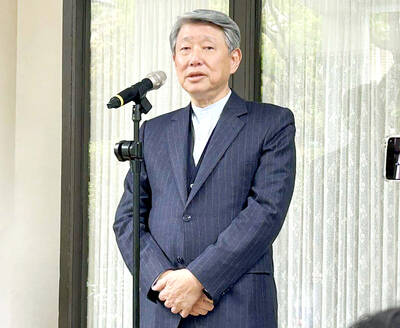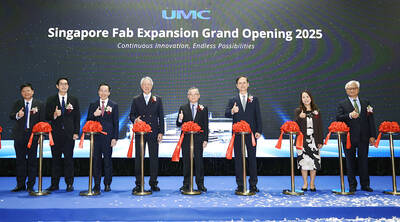Largan Precision Co (大立光電), a leading maker of camera lenses, expects growth to pick up in the final quarter of this year, helped by rising shipments of high-margin products and improving handset demand, a company executive said yesterday.
"We believe the third quarter will be our worst," chairman Lin Yao-yin (林耀英) told an investor's conference yesterday.
With new orders pouring in and increasing shipments of advanced lenses for higher mexapixel camera phones, Lin said "the fourth quarter could be the strongest period for Largan."
"We have no reason to be pessimistic [about the second half] as we already saw some positive signs from our customers," he said.
Largan, which supplies glass and plastic lenses for digital cameras and multifunctional printers, is counting on the mobile-phone industry for growth.
Its major customers include Nokia Ojy and LiteOn Technology Corp (光寶).
Lin's positive outlook came after Largan reported a lower second-quarter results amid gloomy prospects for handsets and digital cameras, which together make up a hefty 60 percent of the Taichung-based company's total sales.
Largan's second-quarter earnings fell nearly 13 percent to NT$312.9 million, or NT$2.88 a share, from NT$378.02 million three months ago.
Its gross margin fell 7 percent during the April to June period, dropping from 59 percent in the previous quarter to 51.6 percent, Largan said.
Company spokesman Charles Chiu (邱東泉), however, said he is confident the firm will achieve this year's financial forecast of NT$1.55 billion in earnings, or NT$14.38 a share.
But the mobile-phone segment's contribution to sales will fall from the company's previous estimate of 40 percent to around 35 percent, he said.
In the first half of the year, earnings climbed to NT$665.52 million, or NT$6.2 per share, up 43 percent from NT$444.95 million a year ago.
Lin said high-margin lens and phone modules for camera phones with megapixel resolution are expected to grow to make up 50 percent of the company's shipments from current 10 percent.
"The new products will offset the lukewarm demand for handsets and become a major engine to drive Largan's profits," said Ken Yu (
Advanced lenses have a 50-percent higher gross margin than VGA-resolution screens, which are now commonly used in digital cameras, or camera phones, Yu said.
Largan is planning to ship 20 million camera lenses and modules this year.
That figure, however, is lower than the estimate of 34 million units projected by an analyst with a US-based investment bank who requested not to be named.
"The lower-than-expected figure provides evidence that mounting inventory remains an issue for handset sector," the analyst said.
Largan shares advanced by 4.41 percent to close at NT$213 on the TAIEX yesterday.

MULTIFACETED: A task force has analyzed possible scenarios and created responses to assist domestic industries in dealing with US tariffs, the economics minister said The Executive Yuan is tomorrow to announce countermeasures to US President Donald Trump’s planned reciprocal tariffs, although the details of the plan would not be made public until Monday next week, Minister of Economic Affairs J.W. Kuo (郭智輝) said yesterday. The Cabinet established an economic and trade task force in November last year to deal with US trade and tariff related issues, Kuo told reporters outside the legislature in Taipei. The task force has been analyzing and evaluating all kinds of scenarios to identify suitable responses and determine how best to assist domestic industries in managing the effects of Trump’s tariffs, he

TIGHT-LIPPED: UMC said it had no merger plans at the moment, after Nikkei Asia reported that the firm and GlobalFoundries were considering restarting merger talks United Microelectronics Corp (UMC, 聯電), the world’s No. 4 contract chipmaker, yesterday launched a new US$5 billion 12-inch chip factory in Singapore as part of its latest effort to diversify its manufacturing footprint amid growing geopolitical risks. The new factory, adjacent to UMC’s existing Singapore fab in the Pasir Res Wafer Fab Park, is scheduled to enter volume production next year, utilizing mature 22-nanometer and 28-nanometer process technologies, UMC said in a statement. The company plans to invest US$5 billion during the first phase of the new fab, which would have an installed capacity of 30,000 12-inch wafers per month, it said. The

‘SWASTICAR’: Tesla CEO Elon Musk’s close association with Donald Trump has prompted opponents to brand him a ‘Nazi’ and resulted in a dramatic drop in sales Demonstrators descended on Tesla Inc dealerships across the US, and in Europe and Canada on Saturday to protest company chief Elon Musk, who has amassed extraordinary power as a top adviser to US President Donald Trump. Waving signs with messages such as “Musk is stealing our money” and “Reclaim our country,” the protests largely took place peacefully following fiery episodes of vandalism on Tesla vehicles, dealerships and other facilities in recent weeks that US officials have denounced as terrorism. Hundreds rallied on Saturday outside the Tesla dealership in Manhattan. Some blasted Musk, the world’s richest man, while others demanded the shuttering of his

Taiwan’s official purchasing managers’ index (PMI) last month rose 0.2 percentage points to 54.2, in a second consecutive month of expansion, thanks to front-loading demand intended to avoid potential US tariff hikes, the Chung-Hua Institution for Economic Research (CIER, 中華經濟研究院) said yesterday. While short-term demand appeared robust, uncertainties rose due to US President Donald Trump’s unpredictable trade policy, CIER president Lien Hsien-ming (連賢明) told a news conference in Taipei. Taiwan’s economy this year would be characterized by high-level fluctuations and the volatility would be wilder than most expect, Lien said Demand for electronics, particularly semiconductors, continues to benefit from US technology giants’ effort